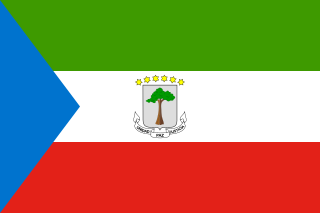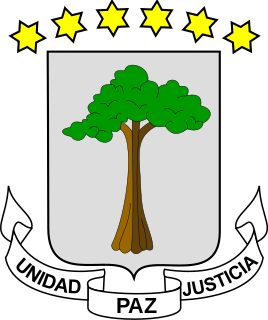
The Flag of Suriname was legally adopted on 25 November 1975, upon the independence of Suriname. Prior to that, there were two different flags. The people of Suriname disapproved of the new flag and in 1959 the government held a national competition to design another flag.

The Arms of Canada, also known as the Royal Coat of Arms of Canada or formally as the Arms of Her Majesty The Queen in Right of Canada, is, since 1921, the official coat of arms of the Canadian monarch and thus also of Canada. It is closely modelled after the royal coat of arms of the United Kingdom with French and distinctive Canadian elements replacing or added to those derived from the British version.

The coat of arms of the Republic of Croatia consists of one main shield and five smaller shields which form a crown over the main shield. The main coat of arms is a checkerboard (chequy) that consists of 13 red and 12 white fields. It is also informally known in Croatian as šahovnica. The five smaller shields represent five different historical regions within Croatia.

The national flag of Cameroon was adopted in its present form on 20 May 1975 after Cameroon became a unitary state. It is a vertical tricolour of green, red and yellow, with a five-pointed star in its center. There is a wide variation in the size of the central star, although it is always contained within the inside stripe.

The national emblem of Cape Verde contains a circle within which is written the name of the nation in Portuguese. Within the circle are a torch and triangle, symbols of freedom and national unity. At the top of the shield is a plumbob, a symbol of righteousness; three chain links are at the bottom. This emblem replaces the earlier variant with the seashell that had been in use since independence. The current emblem was adopted in 1992.

The coat of arms of Australia, officially called the Commonwealth Coat of Arms, is the formal symbol of the Commonwealth of Australia. A shield, depicting symbols of Australia's six states, is held up by the native Australian animals, the kangaroo and the emu. The seven-pointed Commonwealth Star surmounting the crest also represents the states and territories, while floral emblems appear below the shield.

The flag of Equatorial Guinea was adopted on August 21, 1979. The six stars on the map represent the country's mainland and five islands. Under the rule of dictator Francisco Nguema the flag was modified and a different national emblem was used in it. After he was deposed the original flag was restored.

The flag of Papua New Guinea was adopted on 1 July 1971. In the hoist, it depicts the Southern Cross; in the fly, a raggiana bird-of-paradise is silhouetted. The design was chosen through a nationwide design competition in early 1971. The winning designer was Susan Karike, who was 15 at the time.

The Free Papua Movement is an umbrella term for the independence movement established during 1965 in the West Papuan or West New Guinea territory which is currently being administrated by Indonesia as the provinces of Papua and West Papua, also formerly known as Papua, Irian Jaya and West Irian.

The Republic of West Papua is a proposed state consisting of the Western New Guinea region. The region has been administered by Indonesia since 1 May 1963 under several names in the following order: West Irian, Irian Jaya, and Papua. Today the region comprises two Indonesian provinces: Papua and West Papua.

The coat of arms of New Zealand is the heraldic symbol representing the South Pacific island country of New Zealand. Its design reflects New Zealand's history as a bicultural nation, with a European female figure on one side and a Māori rangatira (chief) on the other. The symbols on the central shield represent New Zealand's trade, agriculture and industry, and a Crown represents New Zealand's status as a constitutional monarchy.

The Morning Star flag was a flag used in a supplemental fashion on Netherlands New Guinea to the flag of the Netherlands. It was first raised on 1 December 1961 prior to the territory coming under administration of the United Nations Temporary Executive Authority (UNTEA) on 1 October 1962.

The national coat of arms of Equatorial Guinea was adopted on 21 August 1979.

The national emblem of Papua New Guinea consists of a bird-of-paradise over a traditional spear and a kundu drum. Designed by Hal Holman, an Australian artist working for the Papuan government, Holman was also involved in the design of the National flag. Both the emblem and the flag was accepted by the House of Assembly of Papua and New Guinea and signed into law as the National Identity Ordinance by the Administrator Sir Leslie Johnson on 24 June 1971. The ordinance came into effect after its publication in the Papua New Guinea Gazette of 1 July 1971.
Hai Tanahku Papua was an anthem of Netherlands New Guinea and of the unilaterally declared Republic of West Papua.

The Coat of arms of West Papua was adopted in 1971, when a proposed Republic of West Papua was declared. The design on the shield was in the form of the flag of former Netherlands New Guinea, the Morning Star flag. The shield is supported by a Mambruk pigeon, who holds a drum in its dexter claw and a bundle of arrows in its sinister claw also, and surrounded by an arch in chief with the motto "One People, One Soul". The coat of arms is inspired by the frontispiece of a pamphlet entitled "De Papoea’s roepen Nederland" published in 1951.
The flag and the coat of arms of Negeri Sembilan are state symbols of Negeri Sembilan, Malaysia. The symbols are predominantly depicted in red, black and yellow, traditional colours of the Minangkabau people who are the original settlers in the present-day state. Also recognised in the symbols are the political history of Negeri Sembilan, its ruler, and the state's past relationship with the British Empire.

The Papua conflict is an ongoing conflict in Western New Guinea between Indonesia and the Free Papua Movement. Subsequent to the withdrawal of the Dutch administration from the Netherlands New Guinea in 1962 and implementation of Indonesian administration in 1963, the Free Papua Movement has conducted a low-intensity guerrilla war against Indonesia through the targeting of its military, police, and civilians.
The New Guinea Council was a unicameral representative body formed in the Dutch colony of Netherlands New Guinea in 1961. The council was inaugurated on 5 April 1961 with 28 council members, 16 of whom had been elected in elections held during January 1961.















